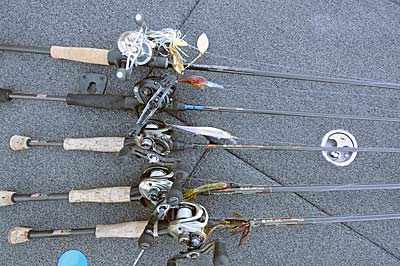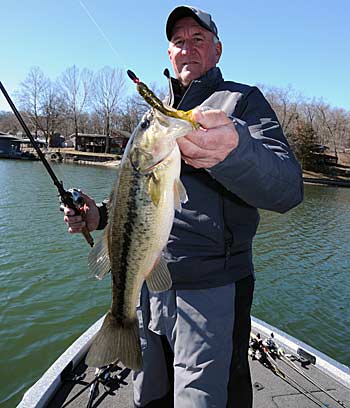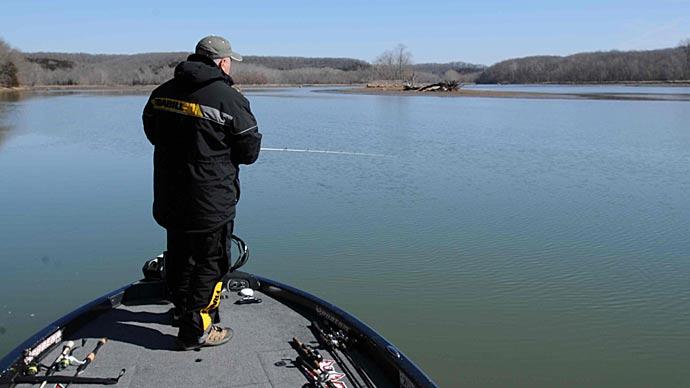
Bass start snapping out of their winter doldrums when daylight hours lengthen and water temperatures rise in the early spring.
"The fish are starting to stage up on the winter banks, but they start getting closer to the spawning pockets," says Jim Dill, who guides Missouri's Lake of the Ozarks. Dill notices that when the length of daylight increases and water temperatures rise into the 40-degree range in early spring, he starts catching bass along transition banks with mixed rock (boulders and chunk rock or chunk rock and gravel).
The warmer water increases a bass' metabolism, so the fish starts feeding more in preparation for the rigors of spawning. Dill's lure selection expands during early spring when more bass forage becomes available as shad die off and the activity of bluegill and crayfish increases.
Here are Dill’s top five lures for catching early spring bass.
- Jig
“I have a lot of confidence in a jig throughout winter and even into spring,” Dill says. He opts for a jig because it mimics a crayfish, a favorite forage for early spring bass craving a food high in protein to help the fish beef up for the spawn. The jig is also Dill’s choice for early spring because he can fish it slow and keep it in the bass’ strike zone longer. Dill opts for the jig when fishing in all weather and water conditions during early spring.
The Missouri guide opts for a 3/8-or 1/2-ounce Crock-O-Gator jig tipped with a plastic trailer featuring subtle action (Crock-O-Gator Ring Craw) or a lively action trailer (NetBait Paca Chunk). Dill favors jigs and green, brown, or black trailers with some orange on the tip.
The jig produces best for Dill when he fishes it from the bank to 15 feet deep. "I am throwing right to the bank because there are days in early spring when the fish will get 2 to 3 feet deep on bright sunny days to scope out their spawning areas or to feed on crawfish,” Dill says. “I tend to hop the jig a lot more in the spring than dragging it. Many times the bite is so subtle that if you are hopping it, you will feel that resistance each time it hops, and when you don't feel it is your indication of a bite.” He imparts short hops with his jig and lets it sit for 3 to 6 seconds before the next hop to give lethargic bass a chance to swim up to the lure and eat it.
The regional tournament competitor throws his jig on a 6-foot 10-inch medium-heavy action Falcon Rods Finesse Jig rod and Team Lew’s HyperMag baitcast reel (8.3:1 gear ratio) spooled with 10- or 12-pound fluorocarbon line.
- Suspending Stickbait
The suspending stickbait is Dill's early spring choice when some wind is blowing, and the water is clear to slightly stained.
The guide relies on various stickbaits for catching suspended bass in the early spring. “I will go through every brand because different ones have different movements, different rattles, and different flashes, and run different depths," Dill says. He also bases his stickbait selection on wind velocity, choosing the lightweight Smithwick Rattlin’ Rogue for light breezes or the heavier Megabass Vision 110 and Spro McStick with its weight transfer feature for throwing into strong winds. His lure color choices are translucent or flashy shades for sunny days and brighter hues such as chartreuse and gold for overcast weather or stained water.
Transition banks, where the rocks change from bluffs to boulders or boulders to chunk rocks, are Dill's favorite targets for presenting stickbaits to early spring bass. He finds bass suspended 5 to 6 feet off the bank on warm days or in deeper water after a cold front.
After pulling his stickbait away from the bank, Dill presents the lure with a series of jerks and pauses to trigger strikes. Dill determines the fish's mood by letting the lure sit for 6 to 30 seconds and paying attention to whether bass hit it on the pause or the jerk.
Dill presents his stickbait with a 6’ 8” Falcon Jerkbait Special rod and Team Lew’s HyperMag 7.5:1 baitcast reel filled with 8-pound fluorocarbon line.
- Crankbait
The crankbait produces early spring bass for Dill on cloudy, windy days in either clear or dirty water. He favors throwing the Spro Rk Crawler, or Storm Lures Wiggle Wart along the same transition banks he presents his stickbaits. The lure banging into the bottom mimics a crayfish, so Dill chooses crankbaits in a natural green hue for clear water or a red craw color for dirty water.
Dill tries to keep his boat parallel to the bank so he can run his crankbait in the strike zone longer. “I work it a little bit and then stop it and work it again," Dill says. “The retrieve is similar to a Carolina rig where you throw it and sweep it down, then catch up to the bait and then sweep it again, trying to keep it hitting bottom and keeping it in the strike zone a long time.”
The Missouri angler uses a lower gear ratio (5.1:1) baitcast reel to slow down his retrieve. He throws the crankbaits on 10- or 12-pound fluorocarbon or monofilament line with a 7’ 1” medium action rod.
- Tube Bait
Image

Jim Dill favors the erratic fall of a tube bait to catch moody bass in the early spring. When the water temperature rises into the upper 40s, Dill pitches a Texas-rigged 4-inch Crock-O-Gator Tube with a 3/0 or 4/0 wide gap hook and 1/4- or 5/16-ounce tungsten worm weight. Dill places a glass bead between the hook and the tungsten weight to create more noise when he bounces the lure on the bottom. He selects a root beer-tinted tube to imitate bluegill in clear water and opts for black neon or black-and-blue hues for fishing stained water.
“A tube has a lot of movement as it is falling or sitting still because of all of its tentacles, so it is just a productive bait in the spring," Dill says. “It has a lot of different erratic falls that just seem to get bass in the spring to bite a lot of times." He fishes the tube in the same water and weather conditions as he does with a jig, but the tube gives him a different presentation for moody bass.
The tournament competitor fishes the tube from 3 to 6 feet deep and employs higher hops--6 to 8 inches off the bottom--than the jig to create an erratic fall. Dill pegs his weight when fishing around brush, but he leaves the weight unpegged, hopping the tube around rocks or along open banks.
Dill selects a 6’ 10” heavy action Falcon Head Turner rod with more backbone for piercing the hook through the plastic tube and into the fish to ensure a better hookset. He presents the tube with the 8.3:1 HyperMag reel and 10- to 15-pound fluorocarbon.
- Spinnerbait
Slow-rolling a 3/4-ounce spinnerbait is Dill’s pick for fishing windy days in dirty water with the water temperature ranging from the mid to upper 40s.
"You are not going to get as many bites on the spinnerbait, but when you do, the fish are great big ones," Dill says.
The Missouri angler chooses a spinnerbait with a lot of flash that he can move slowly along the bottom to imitate big gizzard shad big female bass like to eat. His spinnerbaits usually feature double willowleaf number 4 and 6 blades or a number 6 willowleaf combined with a number 4 Colorado blade. He chooses gold and nickel blades in clear water and white and chartreuse spinners for stained or murky water. His spinnerbait skirt color options are white and chartreuse for stained water and white or gray for clear water.
The Lake of the Ozarks guide adds a swimbait trailer and number 2 or 3 trailer hook to his blade bait. He favors a white or gray 4-inch Zoom Swimmer or 3.5-inch Keitech Swing Impact swimbait for his spinnerbait trailer and dips chartreuse on the tip of the swimbait’s tail.
Dill claims the perfect scenario for presenting a spinnerbait to early spring bass is after a lot of warm rain washes water into the lake from the creeks. He targets shallow cover such as isolated laydowns and brush or dock corners less than 8 feet deep in the backs of creek arms.
The longtime guide slow-rolls his spinnerbait by reeling the lure just fast enough to keep the blades moving but slow enough to make it frequently contact the bottom. “Throw it to the bank and just follow the contour of the bottom to bounce it off the bottom while keeping the blade moving,” Dill says.
Dill’s spinnerbait tackle consists of a 7’ 2” heavy action rod and 7.5:1 Hypermag reel filled with 17- or 20-pound fluorocarbon.




